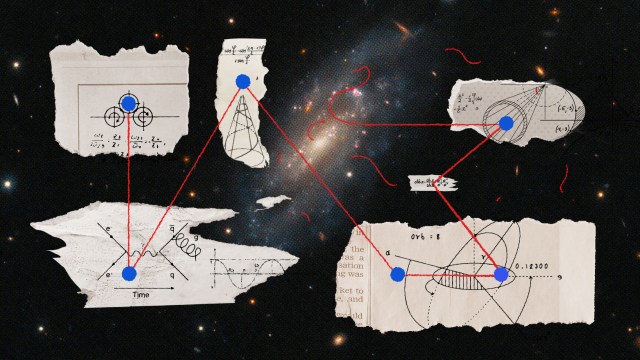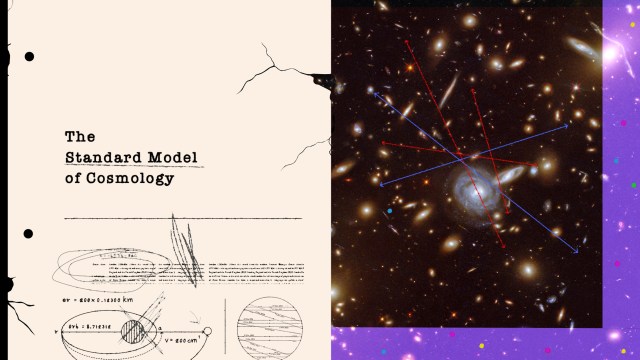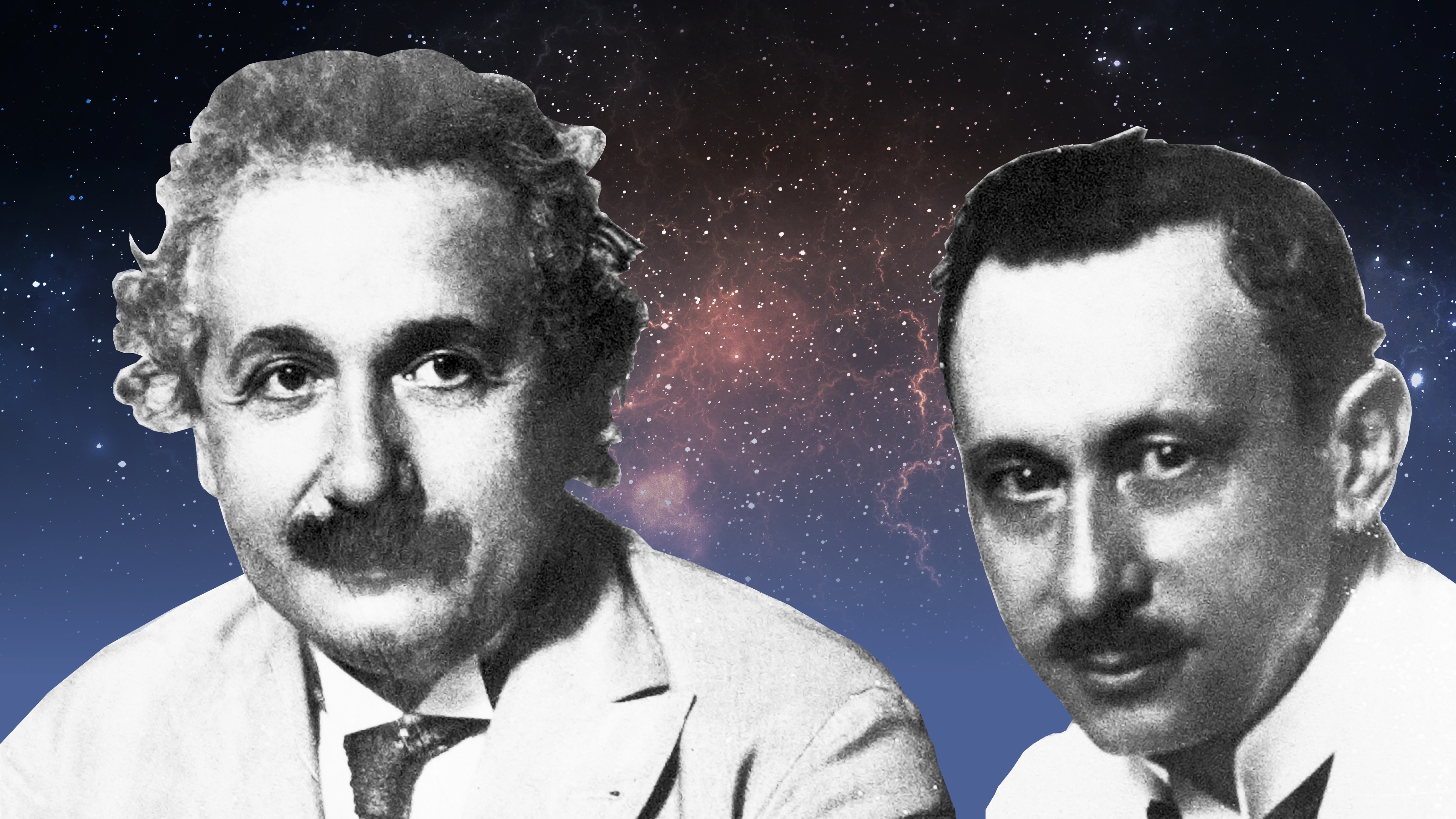Our standard model of cosmology is both a triumph and a jumbled mess

- The classic standard model of cosmology came to be haunted by its own success. The discovery of cosmic microwave background radiation was its most stunning validation, but the universal smoothness of CMB introduced a big problem that needed to be solved.
- The answer found by astronomers was inflation, which was so successful at accounting for CMB and other paradoxes that it laid the base for a new, modern standard model of cosmology.
- The standard model now cobbles together a number of new, different ideas that match up very well to observation. But do they create a coherent model, or merely an ad-hoc placeholder?
When you arrive at graduate school to study cosmology — the science of the Universe — you are about to learn something called the standard model of cosmology. This is the story of the evolution of the cosmos, written in the language of mathematical physics. It starts a tiny fraction of a second after the Big Bang and follows the cosmos up to the current moment. Thousands of scientists have contributed to this story going all the way back to Albert Einstein himself. If you want to know more about the history of contemporary cosmology, I recommend you follow Marcelo Gleiser’s excellent and ongoing special series for 13.8.
Last week, I began my own series looking not at the standard model’s history, but at its problems. A recent paper by astrophysicist Fulvio Melia articulated a series of difficulties that, he claimed, tell us the standard model has reached its expiration date. According to Melia, it is time to look for something new. My goal in this series is to unpack some of the problems Melia presented. I am doing this because each problem brings us to a frontier in our study of the Universe, and because we would all like to know if Melia is right.
It’s not a miracle; it’s inflation
Before we begin to explore the standard model’s problems, we need to ask a simpler question: What is the standard model of cosmology, and how should we think about it?
To get us started, we must step a little on Marcelo’s toes and make a historical point. We need to differentiate between the classic and the modern versions of this model. These two versions of the narrative are a little like the old Battlestar Galactica from the 1970s and the reimagined series from the 2000s. They tell the same story, but with different elements added.
The classic standard model required two conceptual pieces. The first was the stage on which the drama of cosmology would play out, and it came in the form of Einstein’s general theory of relativity. What we get from general relativity is a spacetime that expands continuously starting just after the Big Bang. Into that expanding spacetime, the classic standard model then poured all the matter and energy described in another standard model — the one associated with particle physics.
The central tenet of classic Big Bang cosmology was that the Universe began as a super-hot, super-dense soup of fundamental particles. These particles were described in the standard model of particle physics and included things like quarks, electrons, photons, and other actors. Which particles you deal with depends on when you begin the story. (As you go farther back in time, you run out of data from particle physics experiments to guide your descriptions.) Using the standard model of particle physics, the classic version of the standard model of cosmology then follows the soup of particles and energy as the cosmos expands, cools, and thins out.
The model made many predictions, but its first and most stunning validation came in 1964, when astronomers discovered the Universe was filled with fossilized light left over from a few hundred thousand years after the Big Bang. Cosmic microwave background radiation, or CMB, became one of cosmologists’ most important resources in pushing the bounds of their understanding.
In time, CMB introduced a number of problems or paradoxes to haunt the classic standard model. The most pressing of these was the smoothness of the background radiation. CMB looked the same no matter where astronomers directed their gaze. This implied conditions across widely separated regions of the early Universe were identical. It was like looking at the weather to find every city on the planet had the exact same temperature. Either a miracle occurred in the early Universe, or the cosmic microwave background’s smoothness had a deeper explanation.
Since physicists do not like miracles, they sought the deeper explanation. What they came up with in the 1980s was inflation. According to this new idea, very early in cosmic history, a tiny sliver of spacetime underwent a brief period of tremendous expansion. That blown-up region of the cosmos became our visible Universe. Inflation, driven by a hypothetical, unknown quantum energy field, was so successful at accounting for CMB and the other paradoxes of the classic model that it became the base of the new, modern version of cosmology. As of today, all cosmology is inflationary cosmology.
Cosmology in the dark
The revision did not end there. There were two other additions to the story. The first was the recognition that there was more matter out there than could be seen with telescopes. By tracking the motion of luminous matter — the stuff that emits light — astronomers had to admit that there seemed to be a whole lot more unseen or dark matter exerting a gravitational force. Whatever this dark matter was, it was not included in that standard model of particle physics. It was something new.
While scientists could not directly see dark matter, confrontations between theory and observations told astronomers that whatever it was, this matter was not moving at relativistic speeds. It had to be slower-moving stuff. In other words, the dark matter was “cold.” Further observations showed that the dark stuff constituted the vast majority of cosmic matter. Somewhere around 85% of cosmic mass was dark.
The second addition was another unseen player. Using distant supernovae, astronomers in the late 1990s discovered that the Universe’s expansion was accelerating. This meant the whole cosmos must be full of an invisible form of energy, and this energy was pushing space apart. This dark energy constituted a full 75% of the Universe’s total energy budget.
Inflation, cold dark matter, and dark energy are key players in the modern version of cosmology’s standard model. Sometimes called inflationary cosmology and sometimes labeled the ΛCDM model, this is the story every student must learn and master. What they also will learn is the remarkable concordance between the model and observations. On top of all the successes of the classic version of cosmology’s standard model, the modern version matches key features of ultra-high-resolution maps of the CMB. It also explains features seen in the large-scale distribution of galaxies. Without doubt, the modern standard model of cosmology is a triumph of the scientific process.
Is this model more than the sum of its parts?
On the other hand, it’s also kind of a kludge. What I mean by this is that the modern standard model seems to glue together a bunch of disparate parts without any overarching theoretical structure. Take inflation and dark energy. In both cases, we have a form of pervasive energy that pushes space apart. Inflation does it really fast and then dissipates. Dark energy does it much slower and does not dissipate (well, maybe).
As far as we know, these forces have nothing to do with each other. Inflation was invented in the 1980s to solve a particular set of problems, especially CMB smoothness. Dark energy was added later on to solve another issue, cosmic acceleration. Likewise, dark energy and dark matter are in no way related, and they do not appear in the standard model of particle physics. The dark components were forced into the picture based on observations. But they don’t fit into anything else we know.
Add all this up and there are reasons to wonder about the modern version of the standard model. It is impressive, and its accounts match up to lots of data with astonishing accuracy. But much of it also seems cobbled together out of necessity. It is not hard to imagine some future physicist laughing at the idea of dark matter or dark energy because some cleaner, simpler theory did away with them. So, is there such a theory out there, waiting to be found? Is our standard model just a placeholder for something so different we won’t even recognize the old ideas within the ideas yet to come? That is the point of looking at Melia’s objections to cosmology in its current form. See you next week.



















